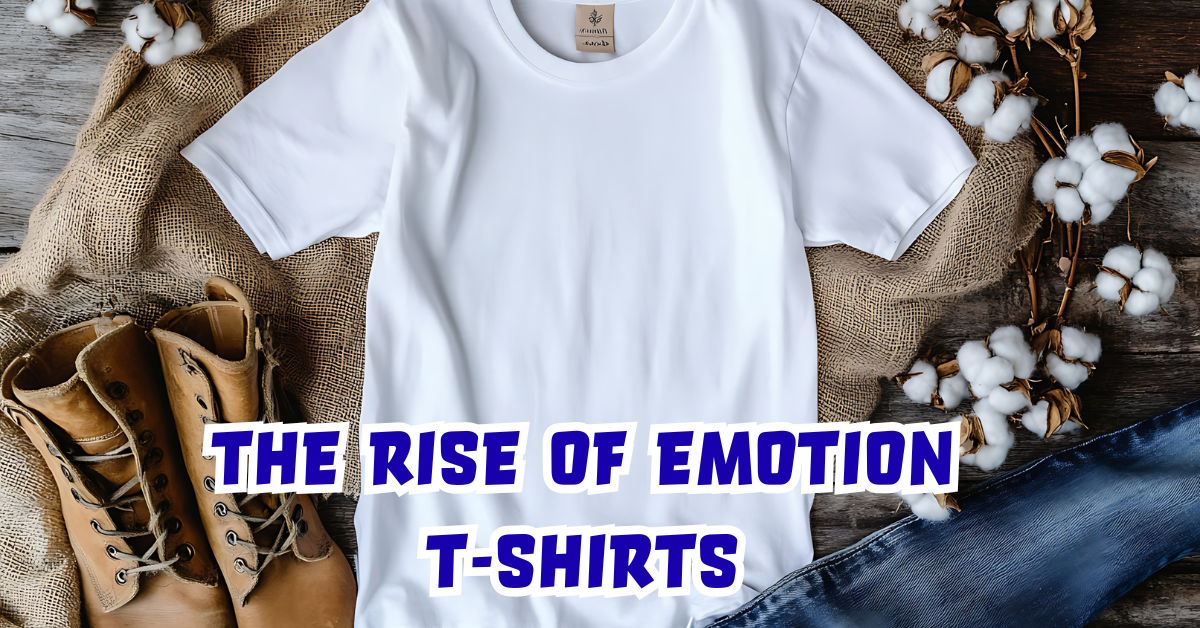In recent years, wearable technology has evolved from simple fitness trackers to sophisticated garments that interact with human emotions. Among these innovations, emotion t-shirts have emerged as a compelling convergence of fashion and technology. Within the first glance, these shirts answer a growing need: people seek to express emotions beyond verbal communication, particularly in an era dominated by digital interaction. Unlike traditional clothing, emotion t-shirts are designed to detect and display emotional cues through color changes, LED patterns, or interactive designs, bridging the gap between personal feelings and external perception. This technology, combined with aesthetic design, allows users to make a statement without uttering a word, creating a dynamic intersection of self-expression, mental health awareness, and fashion innovation.
Fashion experts emphasize that “Clothing has always been a reflection of identity; now technology enables it to reflect inner life as well.” By integrating emotional sensors into soft fabrics, these t-shirts offer a unique communication channel, particularly in social or professional settings where emotional transparency can be beneficial. Beyond their novelty, emotion t-shirts are gaining attention for their potential to assist mental health initiatives, offering insights into mood patterns that can improve emotional regulation.
Understanding the Concept of Emotion T-Shirts
Emotion t-shirts are not just aesthetic wearables; they are technologically advanced apparel designed to sense and respond to human emotions. These garments utilize a combination of sensors, microcontrollers, and conductive fabrics to detect physiological signals such as heart rate, skin temperature, and galvanic skin response (GSR). Based on these readings, the shirt can translate mood into visible indicators, such as color shifts, LED patterns, or even digital projections through connected apps.
| Component | Function | User Benefit |
|---|---|---|
| Sensors (Heart rate, GSR, Temperature) | Detect physiological responses linked to emotions | Accurate real-time emotion tracking |
| Microcontroller | Processes sensor data and triggers visual output | Converts biological signals into understandable displays |
| Conductive Fabric | Facilitates electronic functionality while remaining comfortable | Ensures wearability without sacrificing style |
| LED Display or Color-Changing Fabric | Visual representation of emotional state | Enhances self-expression and social interaction |
| Smartphone App Integration | Provides history and analytics of emotional patterns | Supports mental health awareness and self-regulation |
The integration of these components demonstrates a new paradigm where clothing functions as an interface between human emotion and digital technology. Unlike traditional mood rings or simple emotive accessories, emotion t-shirts provide continuous, dynamic, and context-sensitive feedback, making them an ideal tool for self-expression, particularly for individuals who struggle with verbal communication of feelings.
The Science Behind Emotion Detection in Clothing
Emotion t-shirts operate on the principle that emotional states produce measurable physiological signals. For instance, excitement or anxiety increases heart rate, while calmness reduces it. Skin conductance levels fluctuate with emotional arousal, making galvanic skin response a key metric for emotional detection. By capturing these indicators, sensors embedded within the fabric feed data into a microcontroller, which interprets the signals using pre-programmed algorithms.
“Technology now allows us to visualize the invisible,” notes Dr. Karen Whitfield, a leading researcher in wearable tech. “What was once confined to the human mind can now be shared in a tangible, visual form.”
The algorithms in emotion t-shirts use pattern recognition to distinguish between various emotional states such as happiness, sadness, stress, or excitement. Once the algorithm interprets the data, it triggers an output—such as LED lights glowing red for stress or blue for calmness. This approach merges engineering, psychology, and fashion, creating a multidimensional product that serves practical, social, and emotional purposes.
| Emotion Detected | Physiological Indicator | Visual Output on T-Shirt |
|---|---|---|
| Happiness | Elevated heart rate, relaxed GSR | Yellow glow or animated smile pattern |
| Stress | Increased heart rate, heightened GSR | Red flashing LEDs or alert symbol |
| Calmness | Lower heart rate, steady GSR | Soft blue hue or steady light pattern |
| Excitement | Elevated heart rate with bursts | Pulsating multicolor LEDs |
This table highlights the complex interaction between biological signals and technological output, offering a glimpse into the sophisticated engineering behind emotion t-shirts.
Fashion and Design Integration
While technology forms the backbone, the appeal of emotion t-shirts lies equally in their design. Designers are challenged to integrate sensors and electronics without compromising comfort or aesthetic appeal. Most emotion t-shirts use soft, breathable fabrics like cotton blends or eco-friendly polymers that allow sensor integration while remaining lightweight. Conductive threads, often woven seamlessly into seams or patterns, connect sensors to microcontrollers, making the garments machine-washable in some cases.
Brands experiment with color palettes, patterns, and interactive LED placements to enhance visual storytelling. Limited edition collections may focus on abstract artistic expressions, whereas mainstream models emphasize subtlety for professional or casual settings. Many users view emotion t-shirts not just as a gadget but as a statement piece that communicates personality, mood, and even social intention.
Fashion analysts argue, “The marriage of technology and fashion requires a delicate balance—functionality should not overpower the art of clothing, and the aesthetic must complement the technological features.”
Applications and Practical Benefits
The growing popularity of emotion t-shirts is driven by their versatile applications. These range from personal mood tracking to enhancing social interaction, improving workplace communication, and supporting mental health awareness.
1. Personal Mood Awareness
Emotion t-shirts allow users to track mood trends over time. By connecting to a smartphone app, wearers can analyze patterns, identify triggers for stress or anxiety, and develop strategies to maintain emotional well-being.
2. Social Communication
In social settings, emotion t-shirts act as a non-verbal communication tool. People can intuitively gauge the wearer’s emotional state, fostering empathy and reducing misunderstandings. This is particularly useful in settings like networking events or therapy sessions.
3. Workplace Integration
Some forward-thinking companies integrate emotion t-shirts in corporate wellness programs. By monitoring team stress levels in real-time, organizations can proactively address burnout, allocate tasks efficiently, and improve employee satisfaction.
4. Therapeutic Uses
Mental health professionals are exploring emotion t-shirts as supportive tools for individuals with anxiety, depression, or autism spectrum disorders. By providing a visual representation of inner feelings, these garments encourage self-awareness and external communication.
| Application | Benefit | Example Scenario |
|---|---|---|
| Personal Mood Tracking | Improved self-awareness | Monitoring stress levels throughout the day |
| Social Communication | Enhanced interpersonal understanding | Expressing calmness or excitement in gatherings |
| Workplace Wellness | Preventing burnout | Teams adjust workflow based on collective stress indicators |
| Therapeutic Support | Mental health aid | Assisting patients with emotional expression difficulties |
The Technology Behind Emotion T-Shirts
Emotion t-shirts rely on cutting-edge wearable tech to function effectively. This includes microelectronics, flexible circuits, and biometric sensors. Conductive fabrics serve as invisible wires, transmitting signals from sensors to processing units embedded discreetly in the garment. Battery technology is evolving to provide lightweight, long-lasting power sources, ensuring the t-shirt remains functional throughout daily activities. Some models incorporate solar-powered fabrics or kinetic energy harvesting, further extending usage without compromising comfort.
Machine learning algorithms play a crucial role in interpreting complex physiological data. By continuously learning from user patterns, these algorithms enhance accuracy over time, reducing false readings and adapting to unique emotional baselines. Cloud-based platforms often store historical data, enabling advanced analytics and visualization through companion apps.
Style Variations and Market Trends
The market for emotion t-shirts is rapidly diversifying. Early models focused on LED displays with visible emotion indicators, but newer iterations emphasize subtlety with color-changing fabrics or embedded patterns that reflect mood without overt displays. Sustainability is another trend, with eco-conscious brands offering organic cotton and recycled conductive materials.
Luxury designers are exploring emotion t-shirts as part of high-fashion collections, creating limited edition lines that blend wearable tech with couture aesthetics. Meanwhile, mainstream brands are producing affordable versions, making this innovative technology accessible to a wider audience.
Potential Challenges and Considerations
Despite their innovation, emotion t-shirts face challenges. Privacy concerns are paramount, as sensitive emotional data is collected continuously. Manufacturers must implement secure data handling practices to prevent misuse. Battery life, washability, and durability are technical hurdles that need consistent improvement. Additionally, the social acceptance of wearing garments that reveal internal states varies across cultures, requiring thoughtful design and marketing strategies.
Future Prospects
The future of emotion t-shirts is promising. With advancements in nanotechnology, flexible sensors, and AI-driven emotional analytics, these garments could become more precise, comfortable, and interactive. Potential developments include:
- Integration with virtual reality environments for immersive emotional feedback
- Expansion into sportswear to monitor athlete performance and stress
- Personalized fashion experiences where clothing adapts to user mood and surroundings
- Enhanced mental health monitoring with predictive alerts
As wearable technology continues to blend with everyday fashion, emotion t-shirts are positioned as a cornerstone of a new era of emotional intelligence and self-expression through apparel.
Social and Cultural Impact
Emotion t-shirts are reshaping social norms around emotional transparency. In a world where digital communication often masks true feelings, clothing that reflects inner states fosters empathy, understanding, and meaningful interactions. Mental health advocates are championing emotion t-shirts as tools to reduce stigma, encourage dialogue, and improve emotional literacy in communities.
Top 5 FAQs About Emotion T-Shirts
1. How do emotion t-shirts detect emotions?
Emotion t-shirts use sensors to measure heart rate, skin temperature, and galvanic skin response, which are then processed by embedded microcontrollers to display emotional cues visually.
2. Are emotion t-shirts machine washable?
Most modern emotion t-shirts are designed for durability with washable components. However, some require hand washing or protective care due to embedded electronics.
3. Can emotion t-shirts help with mental health?
Yes, they provide insights into emotional patterns, helping individuals track moods, communicate feelings, and develop coping strategies under professional guidance.
4. Are emotion t-shirts expensive?
Prices vary widely. Luxury designer versions can be costly, whereas mainstream brands offer more affordable options, balancing technology and fashion.
5. Do emotion t-shirts compromise fashion style?
Not at all. Designers integrate sensors subtly, using high-quality fabrics and aesthetic patterns to maintain both comfort and style.
Conclusion
Emotion t-shirts represent a remarkable convergence of fashion, technology, and emotional intelligence. By translating internal feelings into visible cues, these garments redefine self-expression, social interaction, and mental health awareness. They provide practical benefits in personal well-being, workplace efficiency, and therapeutic applications while offering innovative design and style. As technology continues to evolve, emotion t-shirts are poised to become an essential aspect of modern wearable fashion, offering a unique blend of function, creativity, and emotional connectivity. With a future that combines AI, flexible electronics, and sustainable fashion, emotion t-shirts are not merely clothing—they are a revolution in how we communicate, understand, and live our emotions.











